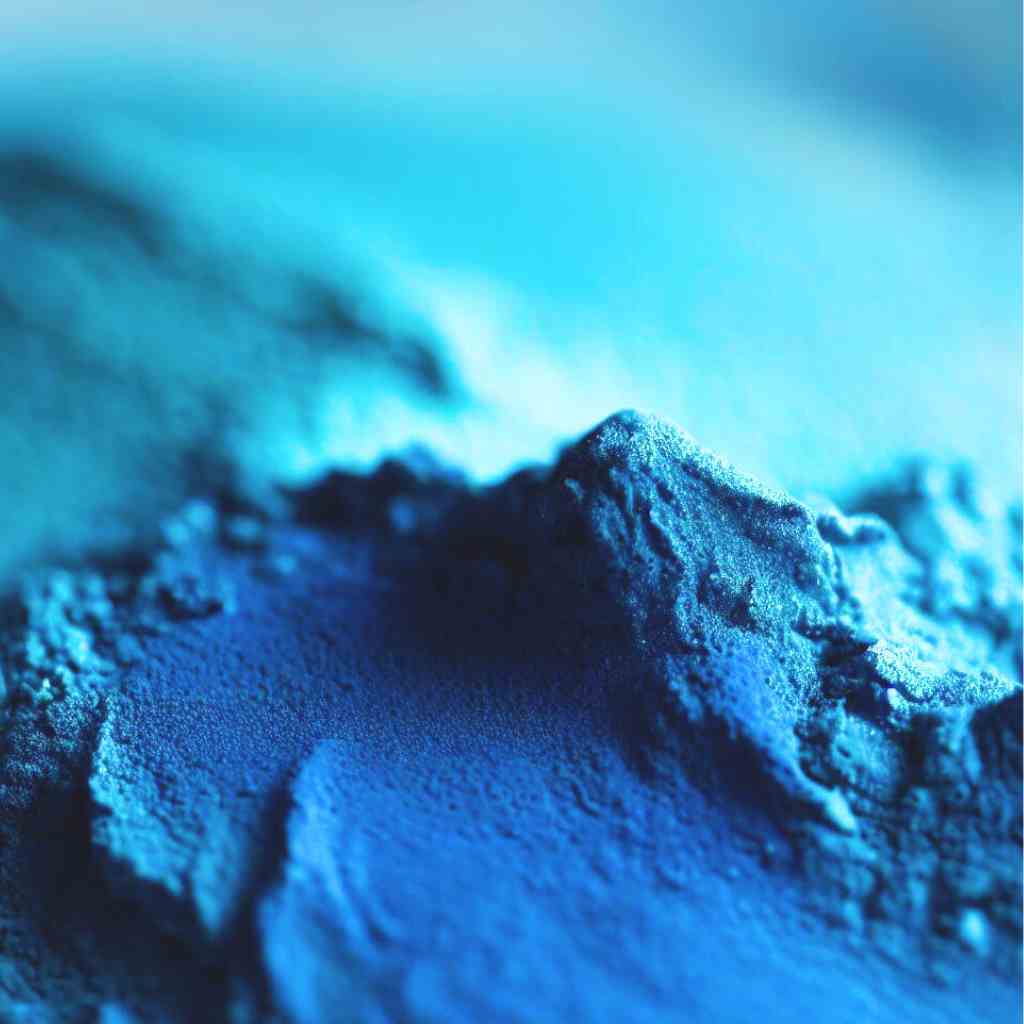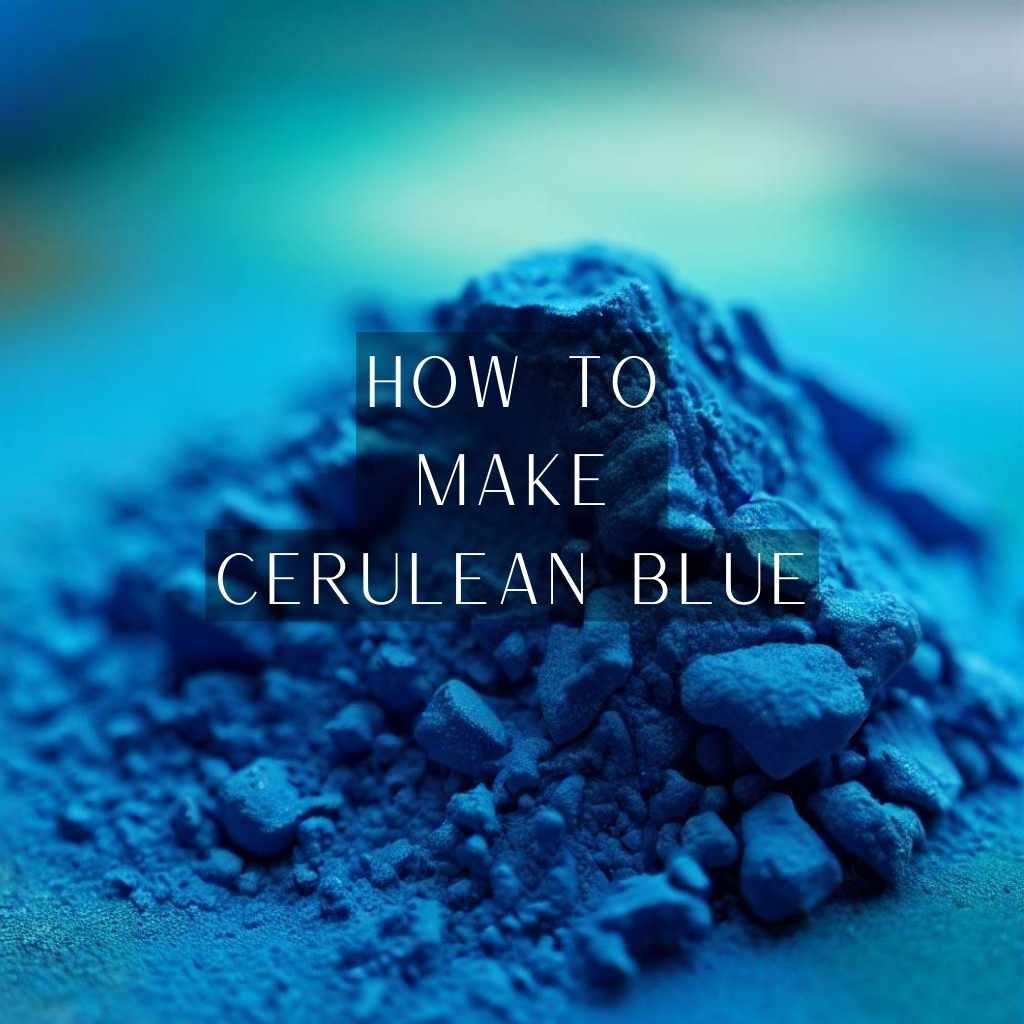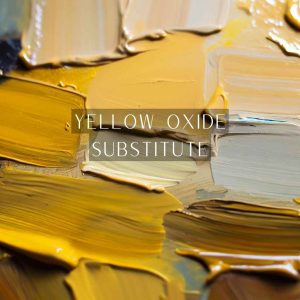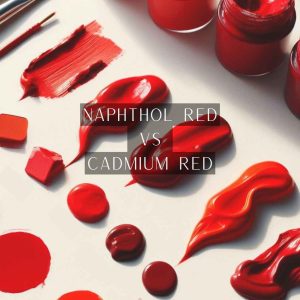In the world of art, colors hold immense power. They can evoke emotions, convey messages, and transport us to breathtaking landscapes. One such color that captivates with its serene and tranquil essence is Cerulean Blue.
From the vastness of the sky to the depths of the sea, Cerulean Blue has the ability to mesmerize and inspire. But have you ever wondered how to make cerulean blue yourself?
In this blog post, we will embark on a journey of discovery as we delve into the realm of Cerulean Blue.
Get ready to unlock the secrets of this captivating color and take your artistic endeavors to new heights.
What is Cerulean Blue?
Cerulean Blue, a captivating hue with a hint of green, is a color that evokes serenity and calmness. Its name originates from the Latin word “caeruleus,” meaning sky-blue, perfectly capturing its ethereal essence.

This cool-toned pigment has become a favorite among artists and designers due to its ability to capture the essence of the sky and the sea.
Characteristics and Properties of Cerulean Blue
- Cerulean Blue possesses unique characteristics that set it apart from other blues.
- With a moderate to high opacity, it provides excellent coverage and layering possibilities.
- Its lightfastness rating ensures that artworks created with Cerulean Blue maintain their vibrancy over time.
- Moreover, its granulating properties create captivating textures, adding depth and interest to paintings.
- Belongs to the cool color family, evoking serenity and calmness.
- Versatile for capturing the essence of the sky, sea, and natural elements.
Variations and Shades of Cerulean Blue
Within the realm of Cerulean Blue, there exist numerous variations and shades to suit diverse artistic needs. Ranging from lighter, delicate shades to deeper and more intense tones, artists have a wide range to choose from.
Some artists prefer Cerulean Blue with a higher green bias, while others lean towards a bluer rendition. These variations allow for versatility in capturing different moods and atmospheres, providing endless creative possibilities.
How to Make Cerulean Blue: Traditional Method
Historically, Cerulean Blue was created using a combination of cobalt salts and tin salts. The delicate balance between these ingredients contributed to the unique color properties of the pigment.
Cobalt stannate, a complex compound formed by the reaction of cobalt and tin salts, was the primary source of traditional Cerulean Blue.
How to make cerulean blue in the traditional way?
The preparation of Cerulean Blue using traditional methods involved meticulous processes that required precision and expertise.
By following these steps, artisans can create high-quality Cerulean Blue pigments with the desired characteristics and properties-
- Mixing the Ingredients and Grinding: Begin by combining the cobalt salts and tin salts in precise ratios. The delicate balance between these ingredients is crucial for achieving the desired color properties of Cerulean Blue.
Once the ingredients are mixed, the next step is to grind them together to break down any larger particles, ensuring a smooth and consistent pigment.
- Controlled Heating: The ground mixture is carefully heated to specific temperatures, such as around 1200°C (2192°F), for a controlled duration, typically ranging from several hours to a day, to form cobalt stannate.
This controlled heating process is crucial for the formation of cobalt stannate, the complex compound responsible for the unique hue of Cerulean Blue.
The temperature and duration of heating must be carefully monitored to avoid any undesirable effects on the final pigment.
- Cooling and Solidifying: After heating, the mixture is allowed to cool, allowing the compound to solidify. This solidification process is essential for stabilizing the pigment and preparing it for further processing.
- Processing and Refining: Once the compound has solidified, it is processed and refined to achieve the desired consistency and quality. This step involves various techniques such as grinding, sieving, and purification to ensure a fine and pure pigment.
- Grinding into Fine Powder: The processed and refined pigment is ground into a fine powder. This final grinding step helps to break down any remaining particles and ensures that the pigment is ready for use.
Challenges and Limitations of Traditional Methods
While traditional methods of producing Cerulean Blue were revered for their rich history, they posed several challenges and limitations. The complex processes involved made the pigment costly and time-consuming to produce.
Moreover, the reliance on finite natural resources posed sustainability concerns. These challenges led to the exploration of modern approaches to create Cerulean Blue.
Modern Approaches to Making Cerulean Blue
Modern developments in pigment technology have revolutionized the production of Cerulean Blue. Synthetic pigments now offer artists and manufacturers a more accessible and sustainable option. These advancements have expanded the availability and range of Cerulean Blue, making it a staple in the artistic community.
Chemical Composition of Modern Cerulean Blue
Modern Cerulean Blue pigments are typically composed of cobalt, chromium, and other elements that contribute to their unique color properties. The precise combination of these elements ensures the desired hue and characteristics of the pigment.
Manufacturing Processes of Modern Cerulean Blue
Modern manufacturing processes of Cerulean Blue involve precise chemical reactions and controlled conditions-
- Specialized equipment and expertise are employed to ensure consistent and high-quality pigments.
- The chemical composition of modern Cerulean Blue typically includes a combination of cobalt, chromium, and other elements, carefully formulated to achieve the desired color properties.
- These synthetic pigments are manufactured through advanced techniques that provide reliable and reproducible results.
- The manufacturing process ensures that the pigments maintain their consistency, color accuracy, and excellent lightfastness.
By utilizing modern approaches, the availability, accessibility, and sustainability of Cerulean Blue have been greatly enhanced, providing artists and designers with reliable and vibrant pigments for their creative endeavors.
How to Make Cerulean Blue at Home?
Here are two DIY methods to make cerulean blue pigments at home-
Homemade Cerulean Blue from Natural Sources
For those seeking a hands-on approach, creating Cerulean Blue from natural sources provides a fulfilling and sustainable alternative.
By gathering specific natural ingredients and employing extraction and preparation techniques, you can create your own Cerulean Blue pigment-
- Gathering Natural Ingredients: The first step in creating homemade Cerulean Blue is to identify plants and minerals rich in the desired pigments.
Azurite, malachite, and certain types of seaweed are potential sources to consider. It’s important to consider the sustainability and environmental impact of the chosen sources.
- Extraction and Preparation Methods: Once you have gathered the natural sources, extraction methods such as grinding, boiling, or soaking can be employed to release the pigments.
These extracted pigments are then purified, processed, and ground into a fine powder, ready for use in creating Cerulean Blue.
- Mixing and Achieving Desired Consistency: To create the desired Cerulean Blue hue, you can mix the homemade pigment with suitable binders or mediums.
Experimentation is key to achieving the desired consistency, transparency, and vibrancy. Adjustments can be made by adding or diluting the pigment until the desired shade is achieved. The process may require several iterations to fine-tune the color to your liking.
Method 2: DIY Cerulean Blue with Synthetic Pigments
Another option for creating Cerulean Blue is through the use of synthetic pigments, which offer consistency and reliability.
By selecting appropriate pigments, utilizing mixing techniques, and adjusting proportions, you can create your own version of Cerulean Blue-
- Selecting Suitable Pigments: Synthetic pigments such as phthalo blue and titanium white can be used as base colors to create Cerulean Blue.
These pigments provide a solid foundation for achieving the desired hue and allow for adjustments to saturation and temperature. Experimentation with different combinations of pigments can yield unique results.
- Mixing Techniques and Proportions: To create Cerulean Blue with synthetic pigments, careful mixing techniques must be employed.
Gradually blending the base pigments, adjusting ratios, and experimenting with the addition of other colors can result in a personalized and unique Cerulean Blue. It’s important to keep track of the proportions used to ensure consistency when reproducing the color in future projects.
- Adjusting Hue and Intensity: Achieving the perfect Cerulean Blue involves fine-tuning the hue and intensity. Adding small amounts of complementary colors or adjusting the ratios of the base pigments can help manipulate the color to your desired specifications.
Through experimentation and careful observation, you can achieve the ideal Cerulean Blue that suits your artistic vision.
Tips for Achieving the Perfect Cerulean Blue
There are some essential considerations when aiming to achieve the perfect Cerulean Blue-
- Proper Pigment Selection: When working with Cerulean Blue, it’s crucial to select pigments with excellent lightfastness and durability.
This ensures that your artwork will maintain its vibrancy and integrity over time. Opting for high-quality professional-grade pigments is recommended for optimal results.
- Balancing Pigment Intensity and Transparency: Cerulean Blue can vary in intensity and transparency depending on the specific pigment used.
Understanding the characteristics of the chosen pigment enables artists to create the desired effects. Experimenting with different ratios, layering techniques, and dilution methods allows for fine-tuning and achieving the desired balance.
- Working with Different Painting Mediums: Different painting mediums, such as oils, watercolors, or acrylics, offer unique properties and handling characteristics.
It’s essential to understand how Cerulean Blue interacts with each medium to maximize its potential. Experimenting and adapting techniques specific to the chosen medium will help artists achieve the desired effects.
- Layering Techniques and Glazing: Layering techniques play a significant role in enhancing the depth and luminosity of Cerulean Blue. By applying multiple transparent layers, artists can create a sense of richness and complexity.
Glazing, the application of transparent layers on top of dried layers, allows for subtle shifts in color and value, adding a captivating quality to the artwork.
Protecting Cerulean Blue from Fading on Artwork
To preserve the vibrancy of Cerulean Blue artwork, it is crucial to protect it from exposure to direct sunlight and harsh environmental conditions. Displaying the artwork away from direct sunlight, using UV-resistant glass or varnishes, and maintaining a controlled environment can significantly extend the longevity of the color.
Cerulean Blue in Various Art Forms
Exploring Cerulean Blue in oil painting, watercolor, and acrylic painting opens up a world of possibilities for artists. Whether it’s capturing the vastness of the sky in oil, creating delicate washes in watercolor, or exploring the versatility of acrylics, Cerulean Blue adds a captivating element to artistic expressions.
Cerulean Blue in Oil Painting
Oil painting offers a rich and versatile medium for utilizing Cerulean Blue. Techniques such as glazing, impasto, and wet-on-wet blending can be employed to create stunning effects with Cerulean Blue.
Artists can explore various applications, such as capturing the vastness of the sky or the tranquility of water, while also experimenting with different brushstrokes and textures.
Notable artists like Claude Monet and Winslow Homer have incorporated Cerulean Blue into their iconic oil paintings, showcasing its versatility and captivating allure.
Cerulean Blue in Watercolor
Watercolor artists embrace the transparent and fluid nature of Cerulean Blue, allowing it to effortlessly blend and flow on the paper. The delicate washes and subtle transitions achievable with this pigment make it ideal for capturing atmospheric effects, distant landscapes, and gentle seascapes.
Artists can experiment with wet-on-wet techniques, layering, and lifting to create captivating watercolor artworks.
Renowned watercolorists like J.M.W. Turner and John Singer Sargent have skillfully utilized Cerulean Blue to evoke a sense of tranquility and luminosity in their works.
Cerulean Blue in Acrylic Painting
Acrylic paint offers artists the ability to explore Cerulean Blue’s versatility with its quick-drying and versatile nature. Artists can employ techniques such as glazing, layering, and dry brushing to achieve various effects.
Cerulean Blue can be used to create striking skies, serene waterscapes, and even abstract compositions.
Notable contemporary artists like Gerhard Richter and David Hockney have incorporated Cerulean Blue into their acrylic paintings, demonstrating its enduring appeal in the art world.
FAQs
- Can I mix different brands of Cerulean Blue pigments?
Mixing different brands of Cerulean Blue pigments is possible, but it is important to consider the differences in composition and characteristics among brands. Each brand may have slight variations in hue, transparency, or intensity. Artists should experiment and test the compatibility of different pigments to achieve the desired results.
- Can Cerulean Blue be mixed with other mediums besides paint?
Yes, Cerulean Blue can be mixed with various mediums besides paint. It can be incorporated into mediums such as ink, pastels, or colored pencils, allowing artists to explore and experiment with different artistic techniques and applications. The versatility of Cerulean Blue extends beyond traditional paint mediums.
- Does Cerulean Blue have any symbolic meanings?
Cerulean Blue is often associated with tranquility, calmness, and serenity. It can evoke feelings of peace, stability, and openness. In some cultural contexts, it may also symbolize spirituality, intuition, or a connection to the divine. However, interpretations and symbolic meanings of colors can vary across cultures and personal experiences.
- Can I use Cerulean Blue for underpainting?
Yes, Cerulean Blue is commonly used for underpainting. Its opaque nature and moderate drying time make it suitable for establishing a base layer in a painting. Underpainting with Cerulean Blue can provide a cool tonal foundation and create depth, enhancing subsequent layers of color.
- How can I make Cerulean Blue appear more vibrant in my artwork?
To make Cerulean Blue appear more vibrant, you can juxtapose it with complementary colors, such as warm oranges or yellows, to create visual contrast and enhance its vibrancy. Additionally, utilizing a higher concentration of the pigment, applying thick paint layers, or incorporating reflective techniques like glazing or impasto can intensify the visual impact of Cerulean Blue.
- Can I mix Cerulean Blue with white to create lighter shades?
Yes, mixing Cerulean Blue with white paint can create lighter shades and tints of blue, ranging from soft pastels to delicate hues. Adjusting the ratio of Cerulean Blue to white will determine the specific shade and the degree of lightness you want to achieve.
- Can I use Cerulean Blue for color mixing purposes?
Absolutely! Cerulean Blue can be used as a valuable component in color mixing. When combined with other pigments, it can contribute to the creation of various greens, purples, and muted tones. Experimenting with different color combinations and ratios involving Cerulean Blue can yield a wide range of captivating and harmonious results.
Conclusion
As we reach the final strokes of our artistic journey, it is time to reflect on the captivating world of cerulean blue and the remarkable possibilities it presents.
Throughout this blog post, we have delved into the depths of knowledge, uncovering the secrets of how to make cerulean blue. We have explored its rich history, understood its characteristics and properties, and even ventured into traditional and modern methods of production.
Now, armed with this newfound understanding, you possess the power to infuse your artistic creations with the serene allure of Cerulean Blue.
Let your brush dance across the canvas, let your imagination soar, and let the essence of this captivating color guide your artistic endeavors.
So, go forth and create, for the world is ready to be immersed in the beauty of your Cerulean Blue creations.





